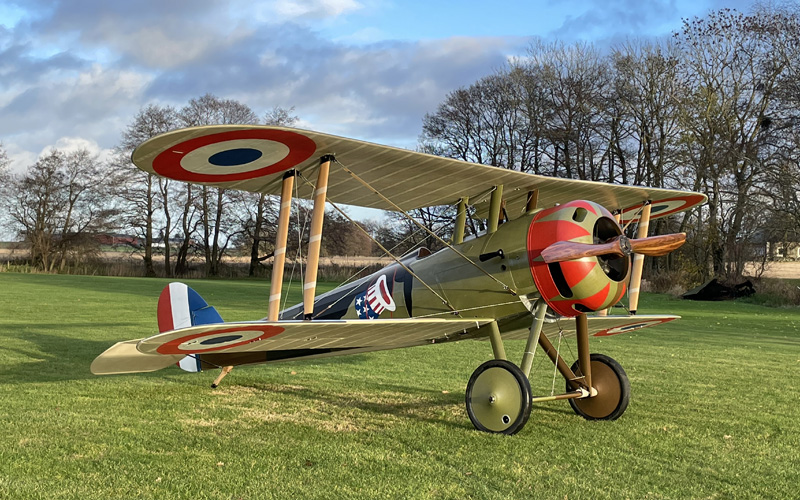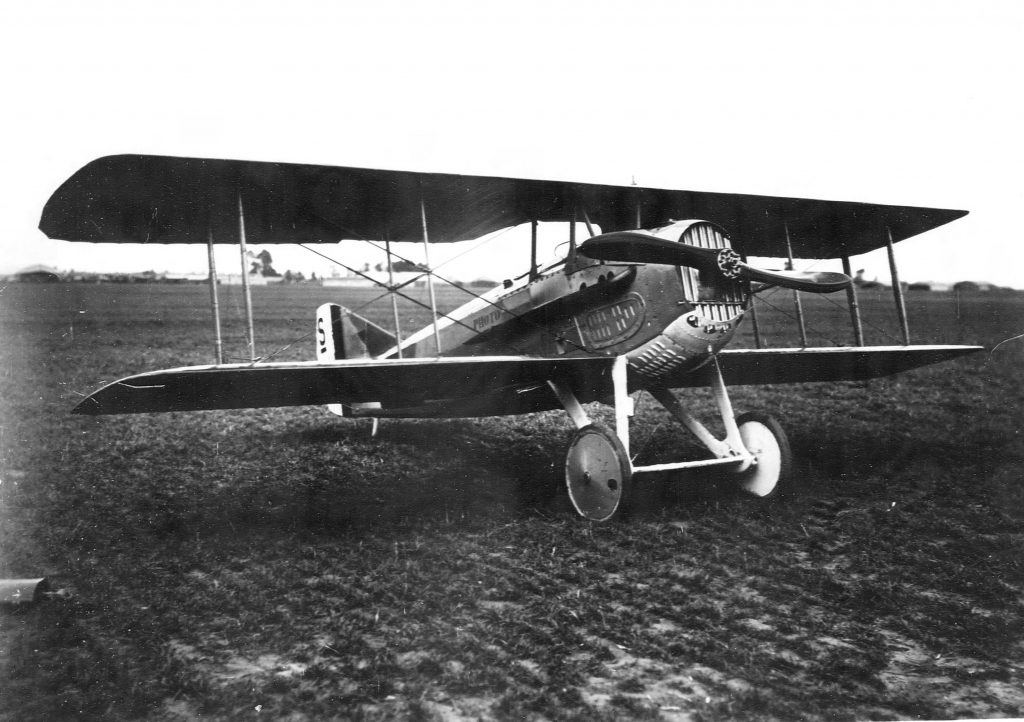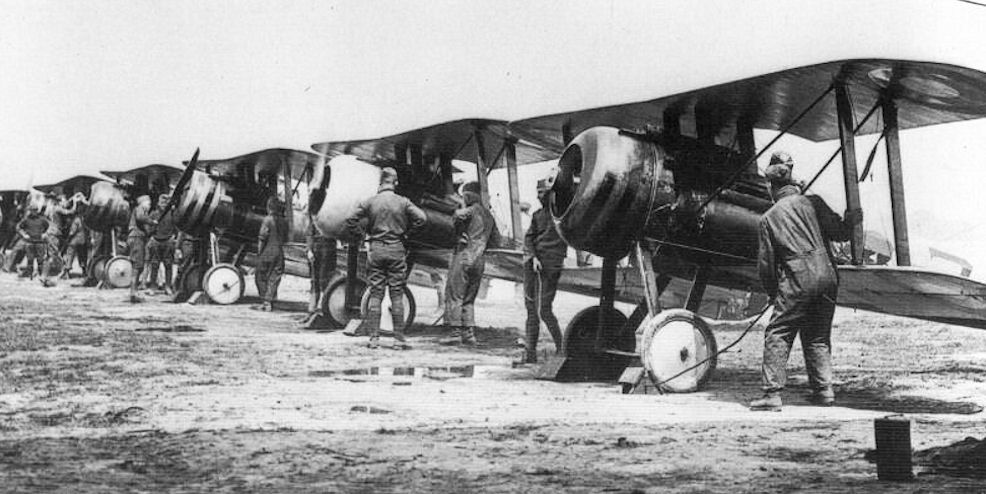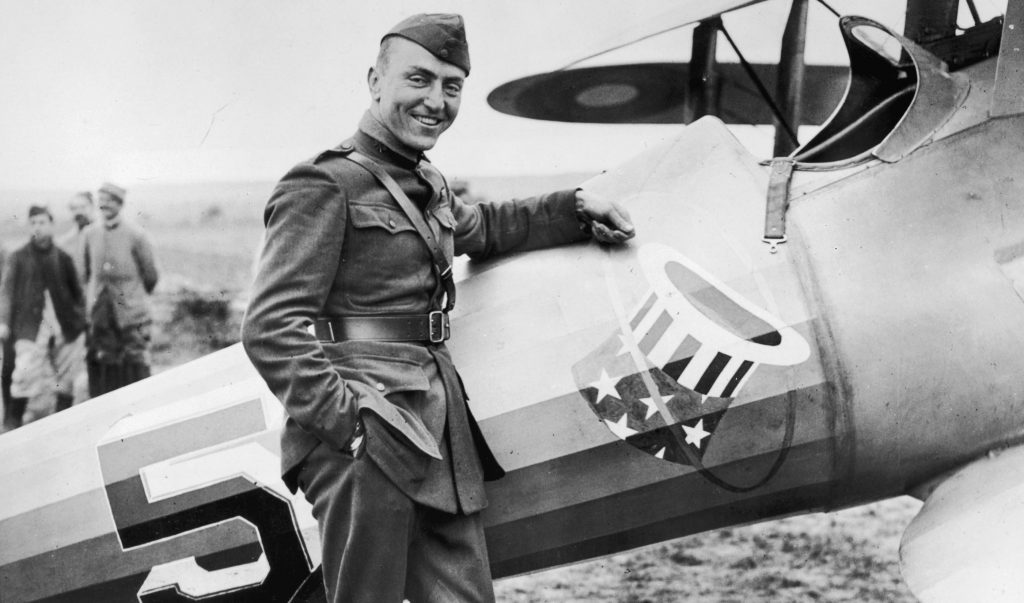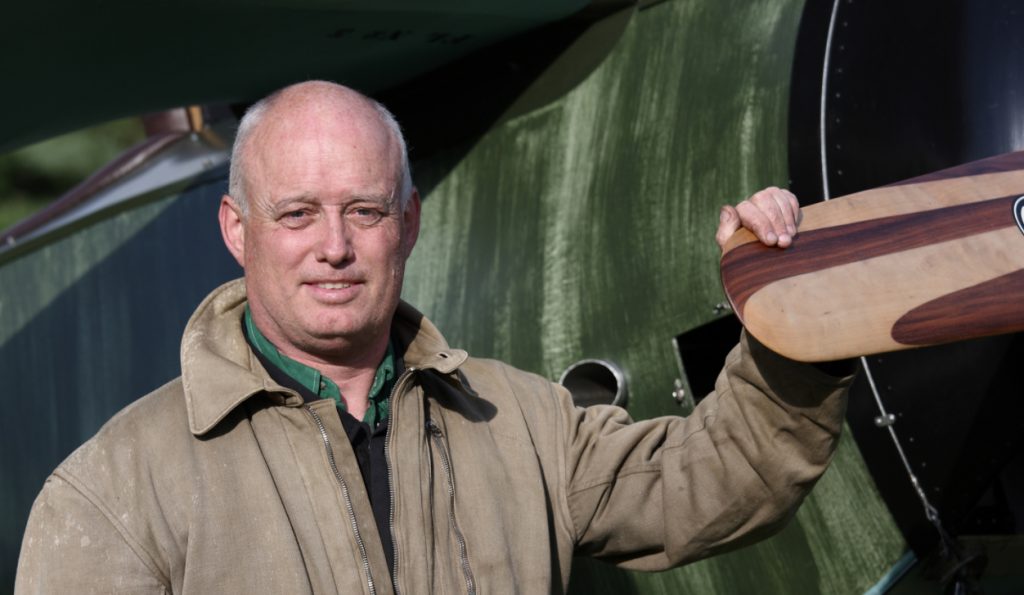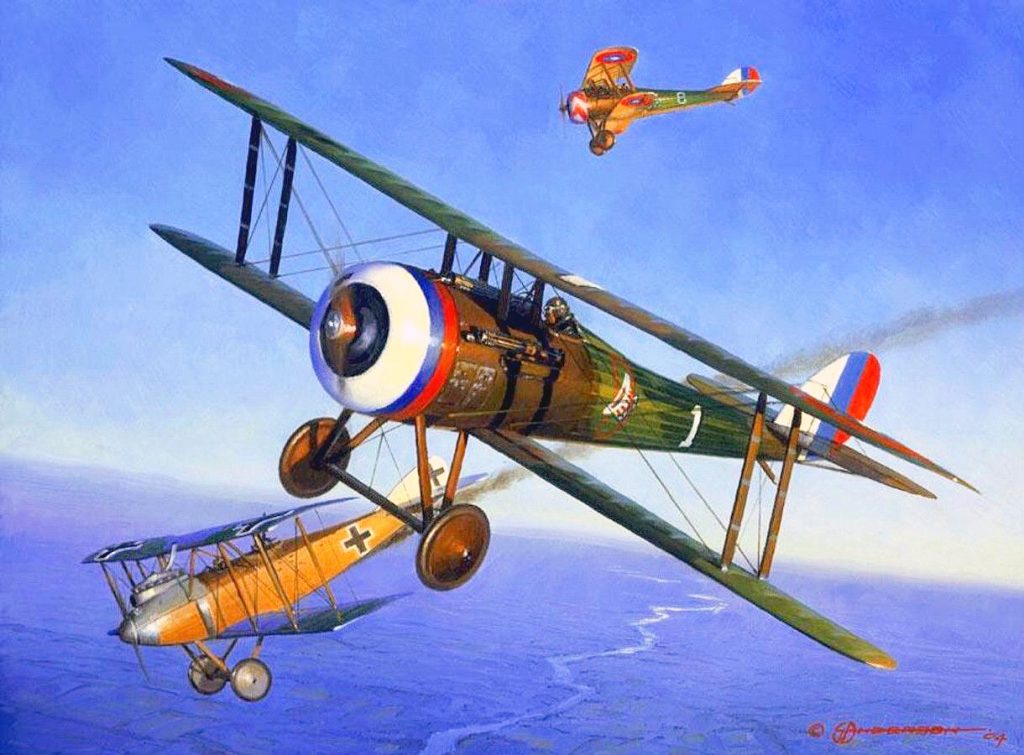
Steve Anderson’s illustration of Eddie Rickenbacker’s 5th victory of a German Albatross C.1 in his Nieuport 28.
In early 1918, with the air war over the skies of France and Belgium reaching their most dangerous point, American pilots with the Allied Expeditionary Force were anxious to take the fight to the German menace. Unfortunately, the French SPAD XIII aircraft they wanted were in short supply. France had trouble with engine production and the formalization of the SPAD as France’s premier front-line fighter. There were simply not enough of the new airplanes to go around. However, at the same time Nieuport had finished their biplane design. After a year of prototypes and re-designs, production had started on the Nieuport 28 (N28). Since France had no need for the new N28, the aircraft were deemed surplus. The American 94th and 95th Aero Squadrons saw an opportunity and began taking the first allotments of the brand new Nieuports in mid-February 1918. When the Americans received the planes there was one minor issue – they weren’t shipped with any armament. Allied Expeditionary Forces didn’t have enough Vickers machine guns to supply the squadrons.
Making the best of a poor situation, the American squadrons set to work on familiarizing themselves with the new 28s. Pilots like future top ace Eddie Rickenbacker, Douglas Campbell, and Quentin Roosevelt (the son of former president Theodore Roosevelt) could be found flying in the cold, early spring skies above friendly territory, learning and developing new tactics so they were prepared when the guns finally arrived. Deliveries of the guns began, albeit in fits and starts, and the first combat patrols were flown in mid-March, with some aircraft
carrying just one machine gun instead of the usual two. The first victories weren’t far behind. On their squadron’s second patrol, pilots Douglas Campbell and Alan Winslow both shot down an enemy aircraft over their home field. As time went on, more and more victories were scored by the American squadrons. The Nieuport 28 became a beloved aircraft in the war against Germany. Unfortunately, Quentin Roosevelt was shot down and killed in July 1918, mere weeks before the AEF began taking deliveries of the more superior SPADs. The Nieuport 28 holds a special place in American aviation history as the first fighter U.S. forces flew into combat.
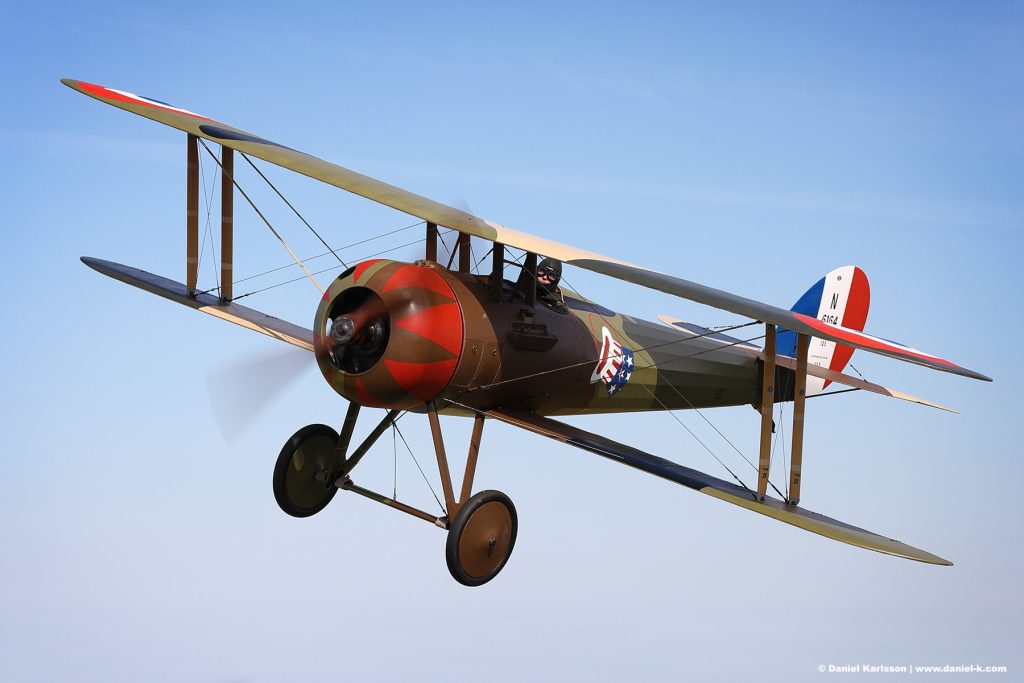
The American Heritage Museum’s Nieuport 28 on its maiden flight piloted by Mikael Carlson in Sweden.
Restoring America’s First Fighter
The Collings Foundation and American Heritage Museum are known around the world for restoring and operating some of the finest and most historically accurate aircraft. This extraordinary N28 restoration honors the designers, pilots, and mechanics of the First World War.
There could not have been a better person to restore the N28 than Mikael Carlson from Sweden. Mikael lives and breaths aircraft from this time period and his in-depth knowledge of how these flying machines were built and operated is truly amazing. This is the sole airworthy original Nieuport 28 in existence, and one of only five on display in the world. Over 80% of this N28 is original along with the very rare and pristine nine-cylinder Gnome Monosoupape 9N rotary engine.
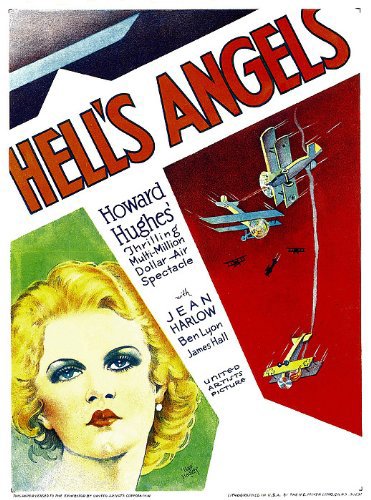 This Nieuport emerged from a factory near Paris, France during late 1918. Following WWI, the American government imported a batch of roughly fifty Nieuport 28s, including our s/n 512, to fill out the ranks of the newly-established U.S. Army Air Service. After retirement from Army use, 512 gained a new lease of life in civilian hands, being used in a number of significant aviation films, such as Hells Angels (1930) and The Dawn Patrol (1930 & 1938). Part of a collection gathered by famed aerial performers Paul Mantz and Frank Tallman, the Nieuport continued flying into the 1960s, and was among the numerous unique airframes put up for disposal at the ‘Tallmantz Auction’ of May, 1968. Legendary racing car builder/driver Jim Hall bought the Nieuport for $14,500. The aircraft had not flown since the early 1970s and largely disappeared from public view until its 2019 donation to the American Heritage Museum.
This Nieuport emerged from a factory near Paris, France during late 1918. Following WWI, the American government imported a batch of roughly fifty Nieuport 28s, including our s/n 512, to fill out the ranks of the newly-established U.S. Army Air Service. After retirement from Army use, 512 gained a new lease of life in civilian hands, being used in a number of significant aviation films, such as Hells Angels (1930) and The Dawn Patrol (1930 & 1938). Part of a collection gathered by famed aerial performers Paul Mantz and Frank Tallman, the Nieuport continued flying into the 1960s, and was among the numerous unique airframes put up for disposal at the ‘Tallmantz Auction’ of May, 1968. Legendary racing car builder/driver Jim Hall bought the Nieuport for $14,500. The aircraft had not flown since the early 1970s and largely disappeared from public view until its 2019 donation to the American Heritage Museum.
It was shipped from Texas in the summer of 2019 to Mikael’s workshop in Sweden. Mikael has previously restored two original Bleriot XI’s, and exact flying reproductions of a Swedish Tummelisa from 1919, Fokker DR.1, Fokker D.VII, and a Pfalz D.VIII — all with original power-plants.
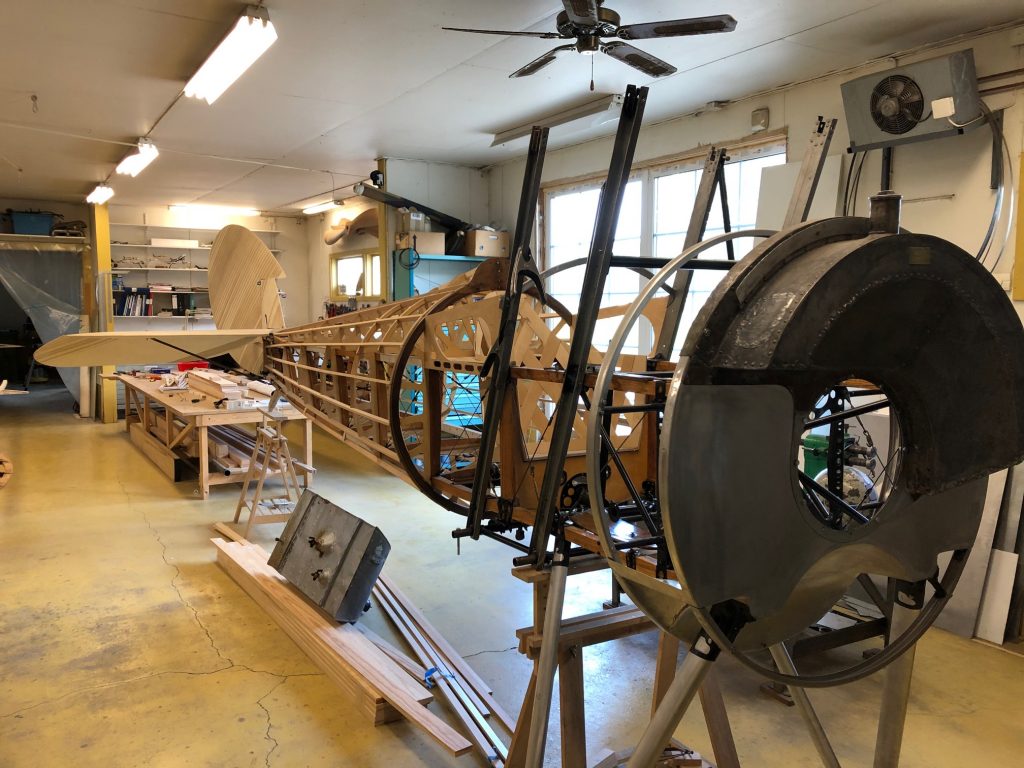 Once the Nieuport 28 was delivered to Mikael, he quickly began the process of evaluating the aircraft’s original structure and condition for restoration to airworthiness. The first order of business was careful disassembly of all components. Being a wooden structure, and more than a century old, it was understood that some parts would be useful only as patterns for exact new-build components. But, to Mikael’s surprise much of the original structure was in excellent condition.
Once the Nieuport 28 was delivered to Mikael, he quickly began the process of evaluating the aircraft’s original structure and condition for restoration to airworthiness. The first order of business was careful disassembly of all components. Being a wooden structure, and more than a century old, it was understood that some parts would be useful only as patterns for exact new-build components. But, to Mikael’s surprise much of the original structure was in excellent condition.
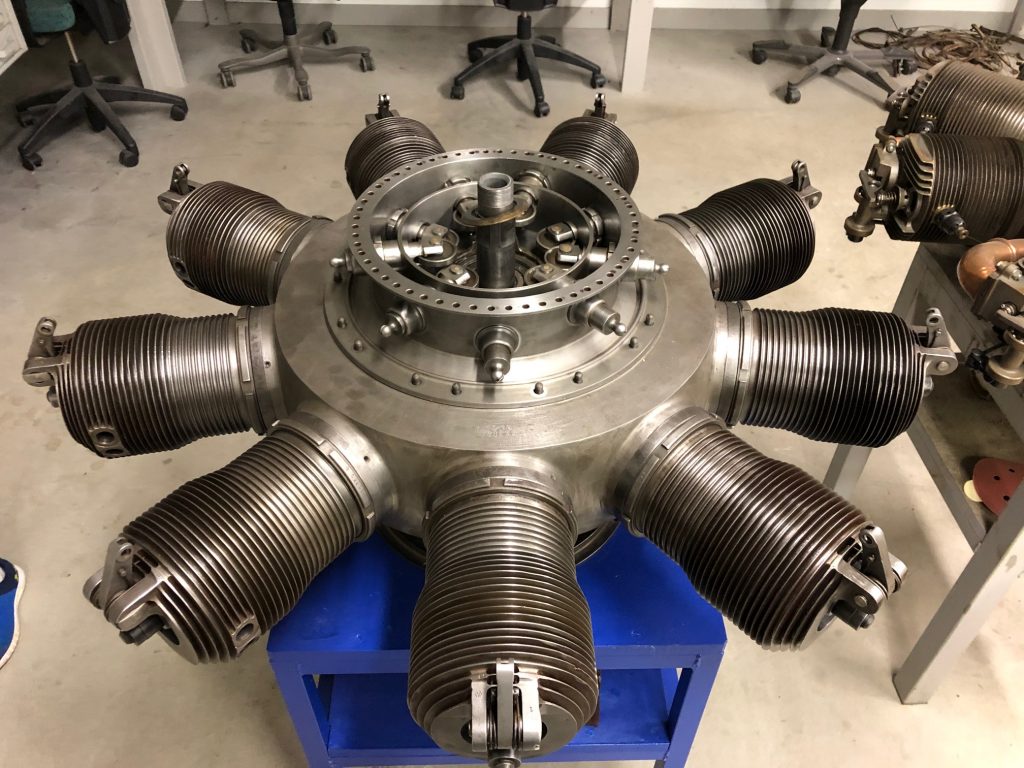 Surprisingly, the original nine-cylinder Gnome Monosoupape 9N rotary engine (pictured above) was in outstanding condition, despite its age. Mikael was able to break down the engine last winter and, drawing on his intimate knowledge of the type, fully overhaul it. The original cowling for the engine was no longer with the aircraft, having been replaced with an inaccurate piece in the 1950’s. So the cowling, a single piece of spun aluminum was recreated. But first, the entire airframe was finished and the engine mount and engine installed. This way, Mikael was able to form the cowling to correct size and shape, within the very tight tolerances of the original design.
Surprisingly, the original nine-cylinder Gnome Monosoupape 9N rotary engine (pictured above) was in outstanding condition, despite its age. Mikael was able to break down the engine last winter and, drawing on his intimate knowledge of the type, fully overhaul it. The original cowling for the engine was no longer with the aircraft, having been replaced with an inaccurate piece in the 1950’s. So the cowling, a single piece of spun aluminum was recreated. But first, the entire airframe was finished and the engine mount and engine installed. This way, Mikael was able to form the cowling to correct size and shape, within the very tight tolerances of the original design.
 Though the original propeller is intact and in great condition, Mikael decided to craft an exact reproduction of the laminated wood propeller with new glue to use for flight trials. The original propeller was reserved, and installed when the aircraft will be placed on static display.
Though the original propeller is intact and in great condition, Mikael decided to craft an exact reproduction of the laminated wood propeller with new glue to use for flight trials. The original propeller was reserved, and installed when the aircraft will be placed on static display.
The primary fuselage structure of the Nieuport was in fantastic shape, with original factory markings and stampings of the late-war manufacturer, Lioré et Olivier, throughout. Though 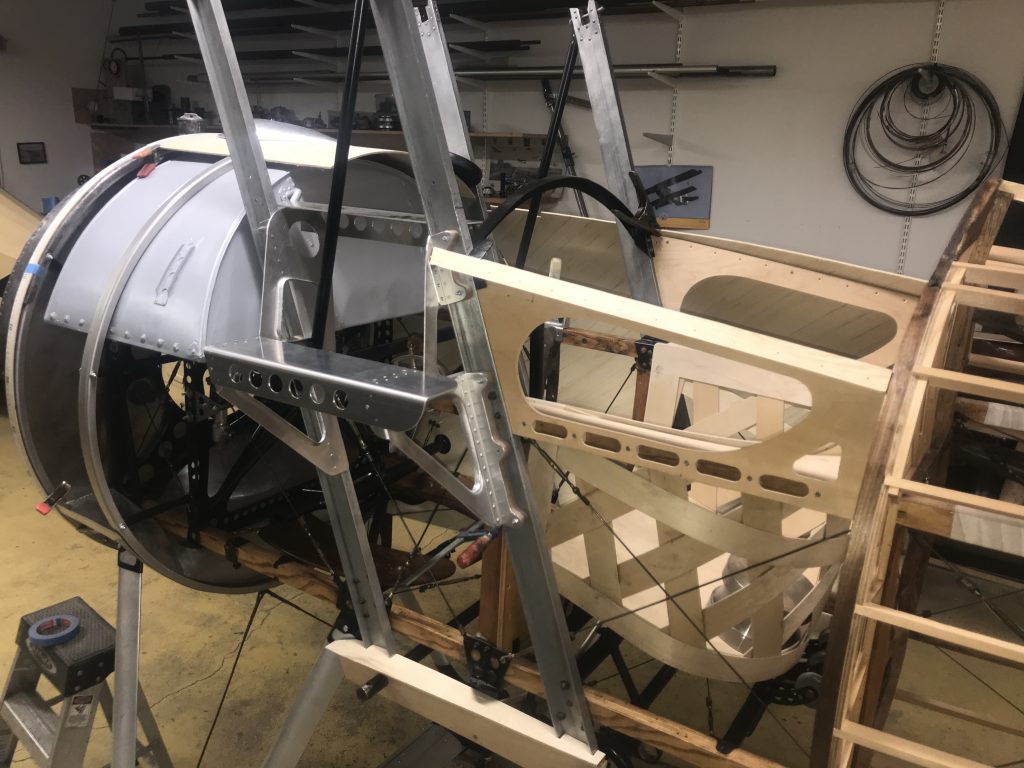 the stringers and upper bulkheads were not original, and would need to be replaced, the primary structure was retained. All metal components were also found to be in excellent condition and utilized in the restoration. The final touches came with hand ground pigment for the paint and decorated in the markings of Douglas Campbell’s original N28.
the stringers and upper bulkheads were not original, and would need to be replaced, the primary structure was retained. All metal components were also found to be in excellent condition and utilized in the restoration. The final touches came with hand ground pigment for the paint and decorated in the markings of Douglas Campbell’s original N28.
Now with the Nieuport 28 completed and test flown by Mikael in Sweden, it was put on a ship to Massachusetts. The aircraft will be reassembled at the American Heritage Museum in time for our WWI Aviation weekend on September 17th and 18th. This is an exceptionally rare opportunity to see this aircraft up close during the exhibition. If the conditions are right, we plan on flying the N28. In addition, we will have additional WWI aircraft such as the SPAD and D.8, WWI re-enactors, camps and rare artifacts from WWI Aces Eddie Rickenbacker and Douglas Campbell on display.
